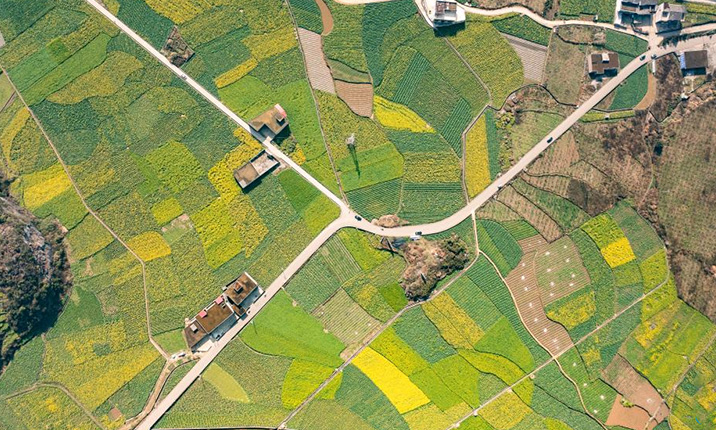High-quality development paves China's path toward modernization
* For a year of great significance to the country's modernization, promoting high-quality development is highlighted as one of the major tasks in the government work report submitted to the national legislature, which began its annual session on Saturday.
* With a departure from the obsolete pattern concentrating on the quantity of growth, China is putting into practice a new blueprint where "innovation is the primary driver, coordination is an endogenous trait, eco-friendly growth prevails, openness to the world is the only way, and shared growth is the ultimate goal."
* After eradicating absolute poverty, the country has set about a new mission of pursuing common prosperity, one of the features of China's modernization drive.
BEIJING, March 6 (Xinhua) -- High-quality development once again grabbed the spotlight as one of the catchphrases at China's ongoing annual "two sessions," which mapped out the 2022 development priorities of the world's second-largest economy.
For a year of great significance to the country's modernization, promoting high-quality development is highlighted as one of the major tasks in the government work report submitted to the national legislature, which began its annual session on Saturday.
Having fulfilled its first centenary goal of building a moderately prosperous society in all respects, China is now striding full-steam ahead toward a modernized future it has pledged.
History has proven that high-quality development is the path China must take. After decades of galloping expansion, the extensive growth model began to exhaust the Chinese economy upon entering the 2010s.
"China's transformation has seen it rise from low-income to upper-middle-income status in just over four decades. Its 20th-century growth story had physical capital at its core," stated Isabella Neuweg and Nicholas Stern, scholars at the Grantham Research Institute on Climate Change and the Environment at the London School of Economics and Political Science, in a paper on China.
"China will transform again in the next 30 to 40 years but this time with wellbeing, quality and sustainability at center stage," Neuweg and Stern forecast in their paper.
With a departure from the obsolete pattern concentrating on the quantity of growth, China is putting into practice a brand-new blueprint where "innovation is the primary driver, coordination is an endogenous trait, eco-friendly growth prevails, openness to the world is the only way, and shared growth is the ultimate goal."

Aerial photo taken on April 6, 2021 shows a view of the automated container terminal of Shanghai's Yangshan Port in east China. (Xinhua/Fang Zhe)
PROSPERITY FOR ALL
After eradicating absolute poverty, the country has set about a new mission of pursuing common prosperity, one of the features of China's modernization drive.
"We must act on the people-centered development philosophy and rely on the efforts of everyone to promote prosperity for all, so as to keep realizing the people's aspirations for a better life," said the government work report.
Rather than "robbing the rich to help the poor" or pursuing egalitarianism, the philosophy of common prosperity China pursues refers to affluence enjoyed by everyone, echoing the objective of high-quality development.
Thanks to the measures aimed at improving people's livelihoods, China's per capita disposable income rose 9.1 percent year on year in nominal terms to reach 35,128 yuan (about 5,550 U.S. dollars) in 2021.
While some Western economies adhere to a trickle-down model, China strives to "make a bigger and better cake" through joint efforts of the people, and then divide and distribute the cake properly through rational institutional arrangements. Last year, the country's urban-rural income ratio narrowed 0.06 to 2.5, continuing a declining trend, data from the National Bureau of Statistics (NBS) showed.
Apart from fueling China's modernization drive, common prosperity has become a recipe for development the world can draw wisdom from. David Monyae, director for the Center for Africa-China Studies at the University of Johannesburg, said China's prosperity vision offers Africa a "new growth platform."
"Through common prosperity, China seeks to pursue a more just development path guided by moral values and a practical program of action," Monyae said.
Jiang Ying, deputy CEO of Deloitte China, said digital technologies will help China push forward common prosperity as the country ushers in an era of digitalization.
By building a digital government, the country is improving its public services, tilting more favorable policies and market information toward rural areas, and creating more opportunities for job seekers and economic growth, said Jiang, who is also a national political advisor.

Aerial photo taken on July 26, 2021 shows a view of Tangshan Huahai project in Tangshan, north China's Hebei Province. (Xinhua/Mu Yu)
INNOVATION-DRIVEN GROWTH
In the pursuit of high-quality development, China is doubling down on technological innovation as a primary driver of growth.
According to official data, the country's total spending on research and development (R&D) hit a new high of 2.44 percent of its gross domestic product in 2021, up from 1.98 percent in 2012.
This year's government work report also stressed the importance of scientific and technological innovation, stating that it helps the country upgrade industries, eliminate the bottlenecks in supply, and realize high-quality development through innovation.
One of the latest moves in the field of innovation came in February, as China approved a megaproject involving the construction of eight national computing hubs and 10 national data center clusters. It is aimed at channeling more computing resources from the country's eastern regions to its less developed yet resource-rich western regions.
This project marks the completion of the overall layout for the national integrated big-data center system, and is expected to better empower the country's digital development.
Thanks to its commitment to innovation, China rose to 12th on the Global Innovation Index 2021 released by the World Intellectual Property Organization. It is the only middle-income economy to rank in the top 30.
Innovation is leading China to ride the wave of digitalization and transform into a global tech hub. Amid the innovation drive, new industries and business models are thriving nationwide.
The value-added output of China's high-tech manufacturing industry increased 18.2 percent year on year in 2021, according to the NBS. Specifically, the output of new energy vehicles and integrated circuit products surged 152.5 percent and 37.5 percent, respectively.
Paolo Bazzoni, chairman of the China-Italy Chamber of Commerce, told Xinhua that China's high-quality development path is "in full harmony" with the values pursued by Italian companies, which place the "highest priority on quality, technological innovation and sustainable development" when investing in China.
"This is the path we want to continue to follow and strengthen," Bazzoni said, noting that opportunities will emerge in sectors such as mechanical engineering, high-quality retail, pharmaceuticals, food and beverage, lifestyle and energy transition.
"China's high-quality development will increasingly match with Italian companies that have invested and will continue to invest in the Chinese market," Bazzoni added.

Aerial photo taken on Dec. 16, 2021 shows the automated production line of a technology company in the Economic Development Zone of Anji County in Huzhou, east China's Zhejiang Province. (Photo by Xia Pengfei/Xinhua)
GREEN SHIFT
In a bid to pursue green growth, an essential part of high-quality development, China has announced that it would strive to peak carbon dioxide emissions by 2030 and achieve carbon neutrality by 2060.
Amid efforts to achieve the carbon-cutting targets, the government work report said the country will work harder this year to address pollution and protect and restore ecosystems, and "promote development while also reducing emissions."
Riding the wave of high-quality development, traditional industries in the country are scrambling for technological transformation and upgrades to make their production more sustainable.
Sinopec, China's largest oil refiner, announced in January that it had completed the country's first megaton-scale project of carbon capture, utilization and storage.
By capturing carbon dioxide from production activities and then either reusing or storing it, the project is expected to reduce carbon dioxide emissions by 1 million tonnes per year, an amount equivalent to the effect of planting nearly 9 million trees.

Aerial photo taken on Dec. 8, 2021 shows a molten-salt solar thermal power plant in Yumen City, northwest China's Gansu Province. (Xinhua/Fan Peishen)
In Zhejiang Province's Lishui City, known as "green valley" for its stunning natural landscape and ecological-conservation achievements, the local synthetic leather industry is transforming from a heavy emitter into a frontrunner of eco-friendly growth to better nurture the city's natural treasures.
According to the government work report, China will continue to promote R&D and application of green and low-carbon technology, develop green manufacturing and services, and encourage the steel, non-ferrous metals, petrochemicals, chemicals and building materials industries to enhance energy conservation and reduce carbon emissions.
Such a green shift is reshaping China into a magnet for global investors dedicated to the use of green energy and technology.
Photos
Related Stories
- Moody's expects China's transportation 5-yr plan to drive infrastructure investment, sustainable development
- China's high-quality development, opening-up benefits world: Chinese FM
- How China's development drives "growbalization"
- Interview: Egypt seeks to learn from China's "unique" development experience: official
- Inclusive development is fundamental way to address inequality, eliminate conflicts: Chinese envoy
Copyright © 2022 People's Daily Online. All Rights Reserved.










